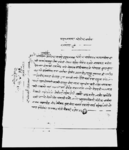A copy of a rukkā of King Surendra reappointing Jagadīśvaranātha as abbot on Siddha Bhagavantanātha's monastic throne (VS 1909)
ID: K_0356_0042
Edited and
translated by Christof Zotter
Created: 2020-09-16;
Last modified: 2020-11-05
For the metadata of the document, click here
The accompanying edition, translation/synopsis and/or commentary are available under the terms of the Creative Commons Attribution-ShareAlike 4.0 International License
Abstract
In the document of which this is a copy the king, who according to the date must have been Surendra, appoints Jagadīśvaranātha as mahanta of Siddha Bhagavantanātha's monastic community in Dang and Salyan after the previous mahanta, Santoṣanātha, breached a rule and kept a woman on site who had become Water-unacceptable for having committed infanticide (jātakamārā).Diplomatic edition
[1r]
1९४नं•[seal]1प्रमांनगीजनरलस्यामवाहादुर•कुंव़र•राणाजी•2पालामा सर्याको¯¯¯¯¯¯¯ ¯¯¯¯¯¯¯ 1हेर्नेस्हीनौहरि•
2भनेसहीनौगणेश•1डाङ्सल्यानाका•श्रीसीद्ध•भगवंन्त
2नाथ•कामठगुठी¯¯¯ ¯¯¯¯¯¯¯¯¯
3¯¯¯¯ ¯¯¯¯¯¯¯¯¯¯¯¯¯¯¯¯¯¯
4प्रस्तीसौ•
5आगेमहंत•जगदिश्वरनाथके•डाङ्••सल्यानाकाश्रीसीद्ध•भगवंन्तनाथ•कामठगादीमा•व•
6सी•स्वास्नीनराषनु•भंन्या•वंन्देज•भय़ामा•महंन्त•संन्तोष•नाथलेजातकमारा•पानीवा•
7हेकभय़ा•कोस्वास्नी•राष्याकोछ•भनि•नीजमहंन्त•जगदीश्वरनाथले•श्रीमद्राज•कुमार•कुमारा
8त्मज•श्री•प्राईम्मीनीस्टरयान्द•कम्यांन्दर•इनचीफ•जनरल्•जंङ्गवाहादुरकुव़रराणा•जी•कम्यांण्ड
9रईनचीफजनरल•वं•वाहादुरकुवर•राणाजीमार्फठविंन्ति•पार्दा•हाम्रा•हजुरमाजाहेरभय़ो
10तसर्थ•मठगादीवसी•स्वास्नी•नराष्नु•भंन्या•भय़ामा•मठगादीमा•पानी•वाहेक•भय़ाकास्वा
11स्नी•राष्याकोथर्दा१९०९सालमासंन्तोषनाथकानाऊमा•भय़ाको•मोहरहानी•१९१०साल•
12पौषवदी•१३रोजदेषि•तिमीलाईमहंन्त्याईगरी•वक्स्यौ•आफ्नाषातीर•ज्मासंग•अघीदेषि•
13चली•आय़ाको•रीतवमोजीममठमादरीय़ाकोजगा•कोअसुलतहसीलगरी•श्रीसीद्धभगवंन्त•
14नाथकामठगादीमा•नीत्य•नैमीत्यक•पुजाभण्डारचलाई•हाम्राजये़मनाईमहंन्त्याईजानी•भो•
15ग्यगर•ईतिसंम्वत१९१०सालमीती•पौषवदी१३रोज४शुभ्म्[seal]
Translation
[1r]
[in the left margin:]
no. 941
[seal]
The order (pramāṃnagī for pramāṅgī) was copied during the tenure of General Syāma Bahādura Kũvara Rāṇājī
He who watched, signature: Nau[sindā]Hari2
He who said, signature: Nau[sindā]Gaṇeśa
[main text:]
Guṭhī [of] the monastic community (maṭha) of the venerable SiddhaBhagavantanātha, Dang [and] Salyana
Āge: to Jagadīśvaranātha (text: Jagadiśvaranātha)
It has come to our notice through Jagadīśvaranātha himself having filed a petition through the venerable prince born of a prince, the venerable Prime Minister and Commander-in-Chief General Jaṅga Bahādura Kũvara Rāṇājī and the Commander-in-Chief General Baṃ Bahādura Kũvara Rāṇājī stating: "Even though there is a rule (bandeja) that states '[he who] sits on the venerable Siddha Bhagavantanātha's monastic throne of Dang (i.e. in the monastery in Śrīgāũ) [and] Salyan (i.e. in the monastery in Rānāgāũ) shall not keep a woman', Mahanta Santoṣanātha has a kept a woman who became Water-unacceptable by reason of infanticide (or abortion: jātakamārā).3 Therefore: When we determined that (?)4 while on the monastic throne he kept a woman who had become Water-unacceptable, although [a regulation] states that '[he who] sits on the monastic throne shall not keep a woman', we annulled the mohara issued in the name of Santoṣanātha in the year [VS] 1909 [and] have granted you the abbotship from [Wednes]day,5 the 13th of the dark fortnight of Pauṣa of the [VS] year 1910 onwards. Conceiving the abbotship [as yours], dutifully enjoy [it] according to the customs that have been practised before—collecting the income due on the land registered under the maṭha, conducting the daily and occasional pūjās and observing feasts from the throne of the maṭha of the venerable Siddha Bhagavantanātha—[while] celebrating our triumphs.
Wednesday, the 13th of the dark fortnight of Pauṣa of the [Vikrama] era year 1910 (1853 CE). 6 Auspiciousness.
[seal]
Commentary
Jagadīśvaranātha, selected by his guru, Mahanta Lokanātha, as successor to Bhagavantanātha's throne, received his first confirmation of the abbotship in VS 1904 (see K_0468_0062), but as we know from another document in the same volume of copied material (see note 1)—a mohara that was annulled by the present document—he was dismissed by King Surendra in VS 1909 for keeping a woman in the maṭha (see K_0356_0032). Jagadīśvaranātha successfully challenged his replacement by Santoṣanātha, so much so that on the very day of his reappointment as mahanta the prime minister wrote to officials in Pyuthana and Salyan ordering them to respect certain privileges enjoyed by maṭha that seemingly had been contested in the past (Naraharinātha VS 2022: 464). Jagadīśvaranātha stayed in office—if not without further controversies (see Naraharinātha VS 2022: 464-465)—until he died and the abbotship passed on to his disciple Khīmānātha in VS 1934 (cf. K_0097_0040).

